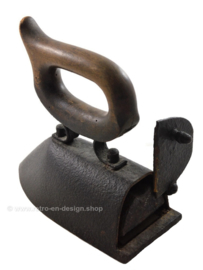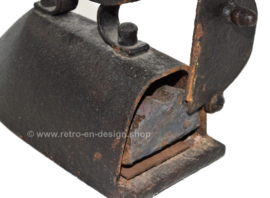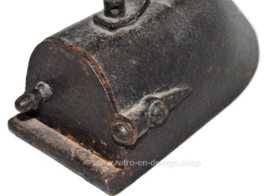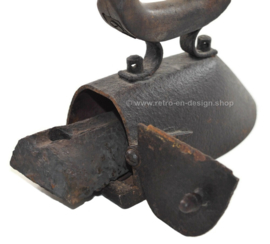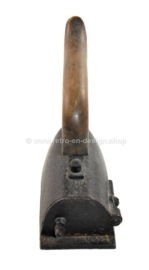A R C H I V E
Antique weighted iron or tailor bolt
SKU: BR-2493-19Antique weighted iron or tailor bolt.
- Manufacture date 1880 - 1910
Description
Hollow triangular iron with wooden handle and hinged back with a crimped wooden handle. At the rear is a flap that opens to the top right. The heating element inside has roughly the same shape as the body of the iron.
This antique tailor bolt dates from around 1890. Unlike the stove bolts, which were heated on the stove, these irons had a metal block on the inside, this block was heated in the fire. These irons therefore remained warm for much longer.
Iron in the word iron refers to the first irons made of cast iron. Heating was often done on the stove. Iron was chosen because material was needed that was heavy and retained the heat well. The iron was born.
Condition
This iron is still in a very good condition with traces of use and age-related traces of wear.
Size
- Height: 19 cm.
- Length: 20.5 cm.
- Width: 8 cm.
Clothes iron
A clothes iron is a device that, when heated, is used to press clothes to remove creases and help prevent the spread of infectious disease.
Domestic irons generally range in operating temperature from between 250 °F (121 °C) to 360 °F (182 °C). It is named for the metal (iron) of which the device was historically made, and the use of it is generally called ironing. Ironing works by loosening the ties between the long chains of molecules that exist in polymer fibre materials. With the heat and the weight of the ironing plate, the fibres are stretched and the fabric maintains its new shape when cool. Some materials, such as cotton, require the use of water to loosen the intermolecular bonds.
Before the introduction of electricity, irons were heated by combustion, either in a fire or with some internal arrangement.
Metal pans filled with hot coals were used for smoothing fabrics in China in the 1st century BC. From the 17th century, sadirons or sad irons (from Middle English "sad" meaning of "solid", used in modern English through the 1800s began to be used. They were thick slabs of cast iron, triangular and with a handle, heated in a fire or on a stove. These were also called flat irons. A later design consisted of an iron box which could be filled with hot coals, which had to be periodically aerated by attaching a bellows. In Kerala in India, burning coconut shells were used instead of charcoal, as they have a similar heating capacity. This method is still in use as a backup device, since power outages are frequent. Other box irons had heated metal inserts instead of hot coals.
Some translations come from an automated system and may contain errors.
Country of origin
The Netherlands - Holland
Kind of object
Antique iron - iron - tailor's iron - bolt - household item
Theme
Ironing - tools - equipment
Category
Brocante - bric-a-brac
Color
Black - brown
Material
iron - wood
Particularities
Hollow version with loose iron heating element
Era
1880 - 1910
Quality
Good vintage condition
Height
19,00 cm
Lenght
20,50 cm
Width
8,00 cm
Shipping method
Parcel post with track & trace











